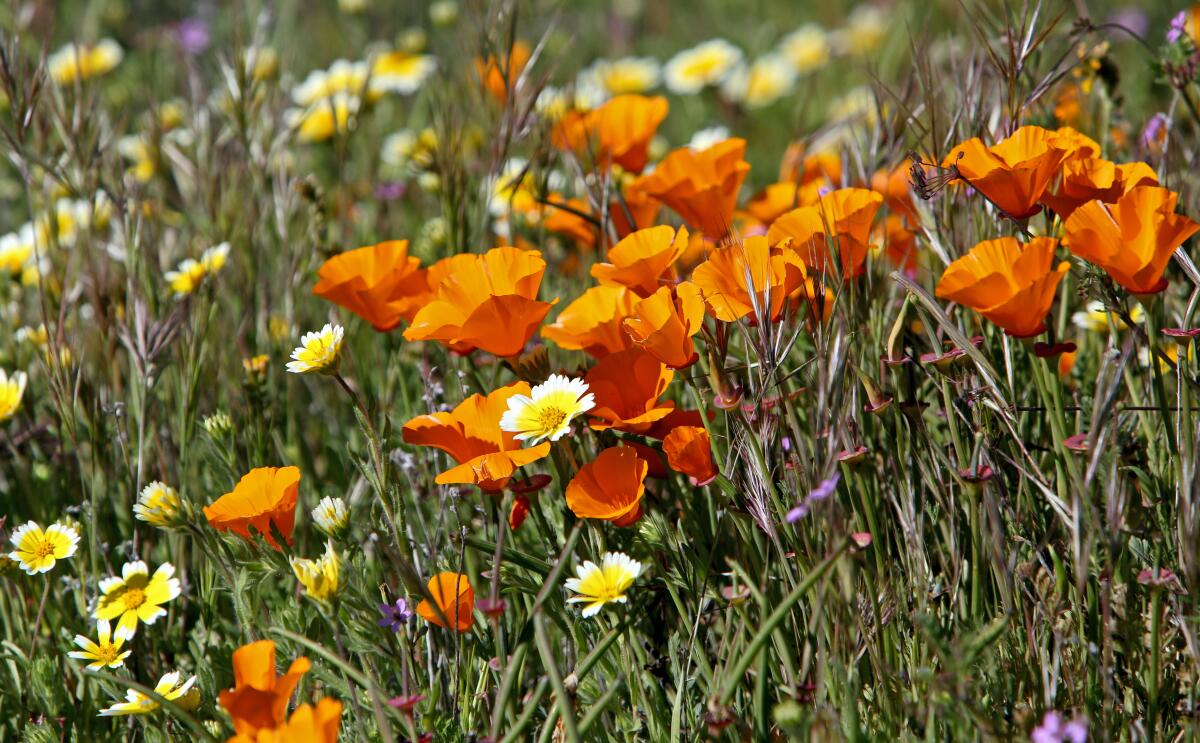Apodaca: Climate change is driving worsening allergies

Springtime in Orange County. Flowers are blooming, birds are serenading and daylight is lingering. Isn’t it glorious?
But also: May Gray. June Gloom. Bugs. And seasonal allergies.
When it comes to the latter, this year is off the charts, at least for me. I’ve spent the better part of the past few months sneezing, wheezing, wiping my weeping eyes, scratching my perpetually runny, itchy nose and consuming box after box of tissues. I’m a real joy to be around.
Fact is, though, it isn’t just me. Allergy, asthma and immunology specialists across the country, including those here in Orange County, are reporting that they are seeing ever-growing numbers of patients seeking relief from their seasonal allergy symptoms. What’s more, those symptoms are increasing in severity.
Not just that. Seasonal allergies — also known as allergic rhinitis or hay fever — aren’t even confined to just one season any more. That is, for many of us, the symptoms are starting earlier in the year and lasting well past the traditional springtime window. Perhaps it’s time to retire the term “seasonal allergies,” since their appearance is quickly approaching a year-round phenomenon.
This occurrence isn’t going unnoticed. News stories have been popping up regularly with headlines assuring readers that they are not imaging things, that allergies really are getting worse.
Even my dog has allergies, poor guy.
So what’s going on? Why can’t I turn off the leaky faucets that my nasal passages have become? Why are my eyeballs on fire? And why can’t a girl keep her makeup from smudging and smearing?
Topping the list of reasons that explain what’s happening is climate change.
The growth in allergies is one of the many ways that our addiction to burning fossil fuels is rapidly changing our environment and impacting our health in profoundly negative ways. As the climate warms, growing zones are shifting, many plants are blooming earlier and longer, and pollen counts are rising — in many areas, those counts have been consistently breaking records.
That means that more pollen and other irritants such as mold particles are being released into the air.
Heavier rainfall and shifting wind patterns due to climate change also contribute to the problem, as does the encroaching vegetation that previously wouldn’t be found in cooler climates. Many people are being exposed to allergens that they previously did not encounter; thus, their resistance might be lower. There’s even some evidence that increased carbon dioxide in the atmosphere causes pollen to become more potent.
The allergic reactions we experience after breathing in these particles result from both genetic and environmental factors. They occur when the immune system detects a foreign substance in the body, triggering the release of histamines, which cause inflammation and boost mucus production.
“Climate change definitely has affected people,” said UC Irvine immunologist and allergist Jenny Lee.
“With climate change — global warming — trees, grasses and weeds have their own growing season, but it’s extending, getting longer.”
In addition, she said, pollinating seasons for different types of vegetation, which previously were more distinct, are now blending into each other. “There’s more overlap,” she said.
Which is yet another reason why allergy sufferers like me can no longer seem to get a break from their symptoms. And those symptoms are nothing to sneeze at. Increased mucus and fluid production can lead to sinus and ear infections, and chronic inflammation is dangerous for those with asthma. Allergy sufferers tend to sleep poorly, and that negatively impacts overall health and productivity.
Unfortunately, treatments for allergies haven’t changed much over the years. We have over-the-counter oral antihistamines and decongestants that lessen the symptoms, and there are steroid nasal sprays that temporarily reduce inflammation. Indoor air purifiers can also help.
But the relief these measures provide is limited and short-lived.
A more effective treatment — one that’s been around for decades — is expensive and time-consuming. Immunotherapy involves giving patients a series of injections containing tiny amounts of allergens in order to desensitize the immune system so that it doesn’t go into attack mode every time those allergens are introduced into the body.
Yet focusing on the treatment part of the equation shouldn’t lead us to ignore what is now obvious — and urgent. The overarching issue here is that we have messed with our environment so recklessly and for so long that we are now reaping the hard consequences of living on a planet that is growing more hostile to our collective health and well-being.
For those who have yet to acknowledge the fact of human-caused climate change, it’s long past time to accept reality. Allergies are getting worse because we have made it so, and this is just one of countless ways that our use of fossil fuels is quite literally making the air we breath toxic.
Humankind created this problem, and it is up to each of us to do our part to fix it. If we are to keep our planet livable, we need everyone fully on board with measures to transition to cleaner sources of energy.
Until then, no one should breath easy.
All the latest on Orange County from Orange County.
Get our free TimesOC newsletter.
You may occasionally receive promotional content from the Daily Pilot.




